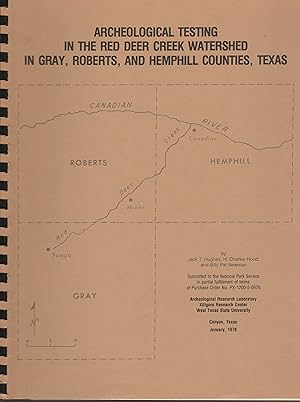Hughes Jack Charles Hood Billy (1 results)
Product Type
- All Product Types
- Books (1)
- Magazines & Periodicals
- Comics
- Sheet Music
- Art, Prints & Posters
- Photographs
- Maps
-
Manuscripts &
Paper Collectibles
Condition
- All Conditions
- New
- Used
Binding
- All Bindings
- Hardcover
- Softcover
Collectible Attributes
- First Edition
- Signed
- Dust Jacket
- Seller-Supplied Images
- Not Printed On Demand
Seller Location
Seller Rating
-
Archaeological Testing in the Red Deer Creek Watershed in Gray, Roberts, and Hemphill Counties, Texas
Published by Archaeological Research Laboratory, Kilgore Research Center, West Texas State University, 1978
Seller: Whitledge Books, Austin, TX, U.S.A.
Book First Edition
Soft cover. Condition: Very Good. No Jacket. 1st Edition. ARCHAEOLOGICAL TESTING IN THE RED DEER CREEK WATERSHED IN GRAY, ROBERTS, AND HEMPHILL COUNTIES, TEXAS (Submitted to the National Park Service) by Jack T. Hughes, H. Charles Hood, and Billy Pat Newman, softcover, probable first edition, illustrated with photos, charts, and a map, 1978. BOOK CONDITION: very good. The text block is in fine condition with no tears, marks, or dog-ears. There is no bookplate nor signature of a prior owner. This is not a library book nor a remainder. Good plastic combe binding. The tan-colored wraps are in very good condition (read covered stamped ?Received, May 19, 1978, Texas Historical Commission). 11 x 8 ½, 182 pages, 18 ounces. NOTE THAT SINCE THE BOOK WEIGHS OVER ONE POUND, THERE MAY BE ADDITIONAL SHIPPING CHARGES IF YOU REQUIRE PRIORITY MAIL OR LIVE OUTSIDE THE U.S. XX [From the abstract] This report summarizes the findings of a 1974 archeological survey and details the results of a 1975 testing project in the Red Deer Creek watershed in the Texas Panhandle, where the Soil Conservation Service is planning construction of 20 floodwater-retarding structures. The 1974 survey recorded 81 sites (72 archeological, 2 historical, and 7 paleontological) in the watershed, 31 of which (30 archeological and 1 paleontological) are located in 15 of the reservoirs. The archeological sites are open occupational areas. Most are temporary camps, mainly late Archaic and late Neo-Indian, with a few early Neo-lndian. Some are late Neo-Indian permanent villages. The villages are located along the main valley. The flint in the watershed is largely from the Alibates quarries to the west. Little was learned about the Archaic and historic remains, but substantial information about the early and late Neo-lndian occupations was gained. The early Neolndian components contain elements of both Plains Woodland and Southwestern Mogollon traditions. The late Neo Indian components are in the Plains Village tradition, but differ from both the Panhandle Aspect to the west and the Custer-Washita River foci to the east. The historic materials may be Faraon Apache.


